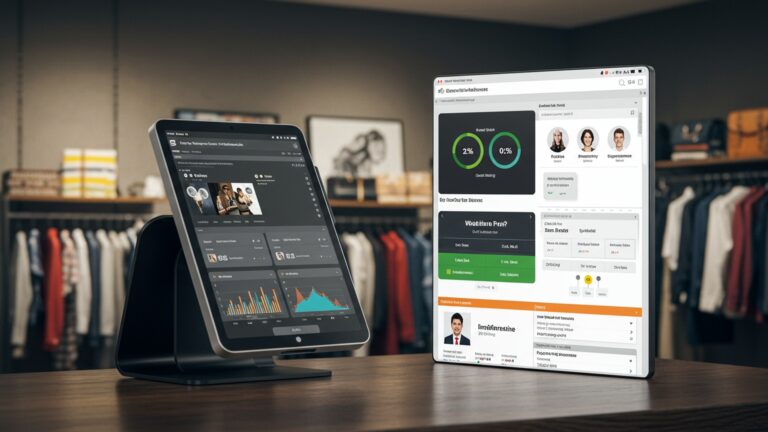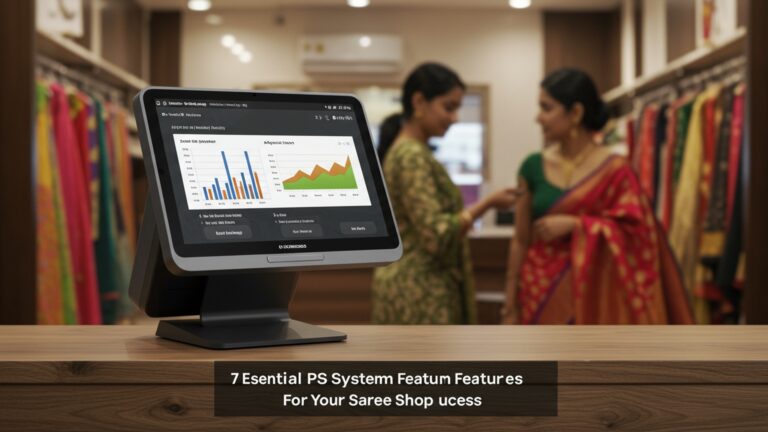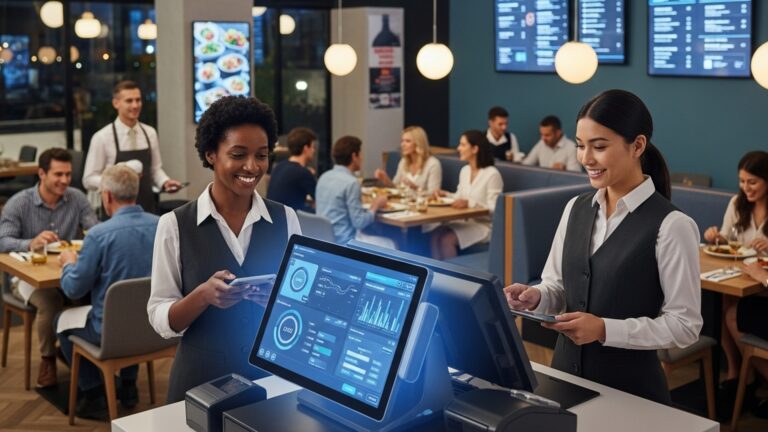Master 8 Ways Restaurant POS Software Enhances Customer Experience and Loyalty
In today’s fiercely competitive restaurant industry, where digital transformation dictates success, merely processing transactions is no longer sufficient; exceptional customer experience is the new currency for loyalty. Modern restaurant POS software has evolved far beyond basic order entry, transforming into a strategic powerhouse that proactively shapes guest satisfaction. Forward-thinking establishments leverage advanced POS functionalities, from AI-driven personalized menu suggestions and seamless mobile ordering integrations to real-time feedback systems and robust loyalty program management. These sophisticated platforms empower operators to anticipate diner needs, minimize wait times. deliver memorable, frictionless service, directly converting first-time visitors into cherished regulars and boosting repeat business in an increasingly digital-first world.
Understanding Restaurant POS Software: More Than Just a Cash Register
In the dynamic world of hospitality, the term Point of Sale (POS) system has evolved dramatically. Historically, a POS was merely a cash register – a place where transactions occurred. Today, modern Restaurant POS software is a comprehensive, integrated system that manages everything from order taking and inventory to customer relationship management and analytics. It’s the central nervous system of a restaurant’s operations, designed to streamline processes, enhance efficiency. crucially, elevate the customer experience.
Think of it this way: when you visit your favorite eatery, every interaction, from browsing the menu to paying the bill, is increasingly touched by sophisticated POS technology. This isn’t just about speed; it’s about creating a seamless, personalized. memorable dining journey that keeps customers coming back. Let’s explore how cutting-edge Restaurant POS software achieves this.
1. Accelerating Service and Ensuring Order Accuracy
One of the most immediate impacts of advanced Restaurant POS software on customer experience is the significant boost in service speed and precision. Gone are the days of handwritten orders leading to deciphering errors or delays. Modern POS systems empower staff to take orders quickly and accurately.
- Digital Order Taking: Servers use handheld tablets or fixed terminals to input orders directly into the system. This eliminates the need to run back and forth to the kitchen, reducing order processing time. For example, a busy lunch rush can be managed far more effectively when orders hit the kitchen display system (KDS) instantly.
- Reduced Errors: Orders are sent directly to the kitchen or bar, often displayed on screens rather than printed tickets. This minimizes misinterpretations and ensures the kitchen staff see exactly what the customer requested, including specific modifications like “no onions” or “extra crispy.” This level of accuracy prevents frustrating mistakes and remakes, leading to happier customers and less food waste.
- Faster Turnaround: With streamlined order flow, dishes arrive at tables quicker. This is particularly crucial for time-sensitive diners, such as those on a lunch break or heading to an event. A quick, accurate meal often translates directly into higher customer satisfaction.
Consider a scenario where a large party is ordering. Instead of one server manually writing down multiple complex orders, a modern Restaurant POS software system allows for quick input, easy modification. immediate transmission to the kitchen, ensuring everyone’s meal arrives correctly and at roughly the same time.
2. Crafting Personalized Dining Experiences
Personalization is no longer a luxury; it’s an expectation. Modern Restaurant POS software provides the tools to grasp individual customer preferences, enabling restaurants to offer truly tailored experiences that foster loyalty.
- Customer Data Management: Many POS systems can store customer profiles, linking past orders, dietary restrictions, allergies. even seating preferences to their name or loyalty account. This data is invaluable for creating a personalized touch.
- Tailored Recommendations: Armed with this details, servers can make informed recommendations. If a customer frequently orders a certain type of wine, the system might prompt the server to suggest a new, similar vintage. If they have a known allergy, the system can flag potential issues on the menu.
- Special Occasion Recognition: The POS can track customer birthdays or anniversaries, allowing the restaurant to offer a complimentary dessert or a special discount, making guests feel valued and celebrated.
For instance, imagine a regular customer, Sarah, who always orders the vegan special and a specific craft beer. When Sarah visits, the Restaurant POS software can alert her server to her preferences, allowing the server to greet her, “Welcome back, Sarah! Would you like your usual vegan special and a ‘Hop Bomb IPA’ tonight?” This small gesture creates a powerful sense of recognition and belonging.
3. Seamless Online Ordering and Delivery Management
The rise of online ordering and third-party delivery services has fundamentally changed how many customers interact with restaurants. Robust Restaurant POS software is essential for managing this complex ecosystem, ensuring a smooth experience from click to delivery.
- Integrated Online Platforms: Many POS systems offer native online ordering modules or seamless integration with popular third-party delivery platforms (e. g. , DoorDash, Uber Eats). This consolidates all orders – dine-in, takeout. delivery – into a single system, simplifying kitchen operations.
- Real-Time Menu Updates: Restaurants can update their online menus, pricing. availability in real-time directly through the POS. If an item sells out, it can be immediately removed from the online menu, preventing customer disappointment.
- Efficient Delivery Logistics: The Restaurant POS software can help manage delivery queues, assign drivers. even provide customers with real-time tracking updates for their orders. This transparency builds trust and reduces anxiety for customers waiting for their food.
A personal anecdote: I once ordered takeout from a new restaurant, only to find out upon arrival that the item I paid for was out of stock. This could have been avoided with a properly integrated Restaurant POS software that updates inventory in real-time across all ordering channels. A restaurant using such a system would have either prevented me from ordering it or notified me immediately to suggest an alternative.
4. Streamlined Table Management and Reservations
Waiting for a table can be one of the most frustrating aspects of dining out. Modern Restaurant POS software addresses this head-on with sophisticated table and reservation management tools, significantly improving the customer’s arrival and seating experience.
- Digital Floor Plans: The POS system displays an interactive digital floor plan of the restaurant, showing which tables are occupied, clean, or ready for seating. This allows hosts to efficiently manage seating, minimize wait times. optimize table turnover.
- Waitlist Management: For busy periods, the system can manage a digital waitlist, accurately estimating wait times and notifying guests via SMS when their table is ready. This frees customers to wait comfortably nearby rather than being tethered to the entrance.
- Online Reservation Integration: Many POS systems integrate with or include online reservation platforms. Customers can book tables directly from the restaurant’s website or app, receiving instant confirmation. This convenience reduces phone calls for staff and provides guests with a hassle-free booking experience.
Imagine a Friday night at a popular bistro. Without a modern POS, the host might juggle a paper reservation book and a mental map of the dining room. With Restaurant POS software, they see a clear overview, can easily adjust for walk-ins. keep waiting guests informed, turning potential frustration into a smooth, positive start to their meal.
5. Robust Loyalty Programs and Rewards
Building customer loyalty is paramount for long-term success. Advanced Restaurant POS software makes it easy to implement, manage. track loyalty programs that genuinely reward repeat business, turning occasional visitors into dedicated patrons.
- Automated Point Tracking: The POS automatically tracks customer purchases, assigning points or credits based on spend. Customers don’t need to remember punch cards; their loyalty is recognized seamlessly at the point of transaction.
- Personalized Rewards and Offers: Based on accumulated points or purchase history, the system can automatically trigger personalized rewards, discounts, or exclusive offers. For example, a customer might receive a free appetizer after their fifth visit or a discount on their favorite dish.
- Enhanced Engagement: Loyalty programs managed through Restaurant POS software often include communication tools, allowing restaurants to send targeted promotions, new menu announcements, or holiday greetings directly to their loyal customers, keeping them engaged and encouraging return visits.
Case Study: A local coffee shop struggled with repeat business until they implemented a POS with an integrated loyalty program. Customers earned a free coffee after every ten purchases. The system tracked this automatically. customers received SMS notifications about their progress and rewards. This simple, automated system led to a 30% increase in repeat customer visits within six months, demonstrating the power of effective loyalty management via Restaurant POS software.
6. Flexible and Secure Payment Options
The checkout process is the final impression a customer has before leaving. A smooth, convenient. secure payment experience is vital. Modern Restaurant POS software systems offer a wide array of flexible payment options, catering to diverse customer preferences.
- Multiple Payment Methods: Beyond traditional cash and credit cards, POS systems support mobile payment options (Apple Pay, Google Pay), contactless payments. even QR code payments. This caters to customer convenience and preference.
- Effortless Bill Splitting: Splitting bills among groups can be a headache. a good POS system makes it simple. Servers can easily divide checks by item, equally, or by specific amounts, eliminating awkward calculations and potential errors.
- Pay-at-Table Functionality: Handheld POS devices allow servers to process payments directly at the table. This enhances security (cards never leave the customer’s sight), speeds up table turnover. offers a premium, convenient service experience.
- Enhanced Security: Modern Restaurant POS software often incorporates EMV chip card processing and point-to-point encryption (P2PE), protecting sensitive customer financial data and building trust.
// Conceptual representation of a payment flow in a modern POS
function processPayment(orderId, paymentMethod, amount) { if (paymentMethod === "creditCard") { // Securely process EMV chip or contactless card via integrated terminal console. log("Processing credit card via P2PE for order: " + orderId); } else if (paymentMethod === "mobilePay") { // Handle Apple Pay/Google Pay tokens from customer device console. log("Processing mobile payment for order: " + orderId); } else if (paymentMethod === "cash") { console. log("Processing cash payment for order: " + orderId); } else { console. log("Unsupported payment method.") ; } // Update order status, generate receipt console. log("Payment successful for order: " + orderId);
}
This flexibility ensures that customers can pay how they want, quickly and securely, leaving them with a positive final impression.
7. Real-Time Feedback and Proactive Issue Resolution
Customer feedback is a goldmine for improvement. modern Restaurant POS software provides mechanisms to collect it efficiently and act upon it swiftly, turning potential negative experiences into opportunities for loyalty.
- Integrated Feedback Channels: Many POS systems allow for direct customer feedback through digital surveys accessible via QR codes on receipts or tables, or even directly on payment terminals.
- Instant Alerts: If a customer leaves negative feedback or highlights an issue, the system can be configured to send instant alerts to management. This enables proactive resolution while the customer is still on-site or shortly after their visit.
- Demonstrating Care: By actively soliciting and responding to feedback, restaurants show customers that their opinions are valued. A quick, empathetic response to a complaint can often salvage a customer relationship and even turn a detractor into an advocate.
For instance, a customer might use a QR code on their receipt to report that their steak was undercooked. The Restaurant POS software immediately alerts the manager, who can then approach the table, apologize, offer a replacement or discount. rectify the situation before the customer even leaves a public review. This swift action transforms a potentially negative experience into a positive one.
8. Data-Driven Menu Optimization and Pricing
Behind every great customer experience is a well-crafted menu and smart pricing. Restaurant POS software provides invaluable data and analytics that enable restaurants to continuously refine their offerings, ensuring customers always find appealing and well-priced options.
- Sales Analytics: The POS tracks every sale, providing detailed reports on popular dishes, slow-moving items, peak sales times. average check sizes. This data is critical for understanding customer preferences.
- Inventory Management Integration: By linking sales data with inventory, the POS helps identify ingredient usage, potential waste. optimal ordering quantities. This ensures popular items are always in stock and reduces the frustration of “sorry, we’re out of that.”
- Optimized Menu Engineering: With insights into profitability and popularity, restaurants can make data-driven decisions about menu design. They can highlight high-profit, popular items, remove underperforming ones. adjust pricing strategically to offer better value to customers while maintaining profitability.
- Targeted Promotions: Understanding what sells best and when allows for the creation of effective promotions and daily specials that align with customer demand, increasing satisfaction and perceived value.
Comparison of Traditional vs. POS-Driven Menu Analysis:
| Feature | Traditional Menu Analysis (Manual) | POS-Driven Menu Analysis |
|---|---|---|
| Data Collection | Manual counting of sales, subjective observations. | Automated, real-time tracking of every transaction. |
| Accuracy | Prone to human error, incomplete data. | Highly accurate, comprehensive, detailed. |
| Speed | Labor-intensive, slow to generate insights. | Instant reports and dashboards. |
| Insights | Basic understanding of bestsellers. | In-depth analysis of popularity, profitability, ingredient usage, peak times, customer segments. |
| Actionability | Delayed, reactive decisions. | Proactive, data-backed decisions for menu changes, pricing. promotions. |
By leveraging the analytical power of Restaurant POS software, establishments can ensure their menu is always fresh, appealing. aligned with what customers truly desire, leading to a more satisfying dining experience and stronger loyalty.
Conclusion
Ultimately, a restaurant POS system is far more than just a transaction processor; it’s the nerve center for crafting unforgettable customer experiences and fostering deep loyalty. Having personally seen countless establishments transform, my advice is to view your POS not merely as a tool for ringing up sales. as a powerful data engine that enables personalized service and predictive marketing. In today’s competitive landscape, leveraging features like integrated loyalty programs, seamless online ordering. personalized offers based on past preferences—think about how a smart POS can remember a diner’s favorite gluten-free dish—is crucial. This proactive approach not only streamlines operations but genuinely makes diners feel valued, turning first-time guests into regulars. Embrace these capabilities, optimize your usage. empower your staff to fully utilize its potential for an unparalleled dining journey. Your diners will undoubtedly notice and reward your establishment with their continued patronage and enthusiastic recommendations. To truly maximize its impact, remember to continually refine your strategy by optimizing your restaurant POS usage.
More Articles
Discover 10 Smart Ways Restaurant POS Software Boosts Profits
7 Essential POS Features Restaurant Owners Must Learn to Master
Your Guide to 6 Key Integrations for Restaurant POS Success
How to Choose The Best Restaurant POS System A 5 Step Guide
10 Essential POS Software Features Every Restaurant Owner Needs to Know
FAQs
So, how does the “Master 8 Ways” POS software actually make dining out better for me?
It streamlines everything from ordering to payment, making service faster and more accurate. Plus, it helps the restaurant remember your preferences, tailor offers. manage loyalty points, creating a smoother and more personalized experience every time you visit.
Can this system really help restaurants build customer loyalty?
Absolutely! It’s designed to integrate loyalty programs seamlessly. Restaurants can easily track points, manage rewards, offer personalized discounts. even remember past orders. This makes customers feel valued and encourages them to return often to enjoy their benefits.
Will I get my food faster with this kind of POS?
Definitely! The software speeds up order taking and sends it instantly to the kitchen, cutting down on manual errors and wait times. Payments are also processed much quicker, so you can enjoy your meal and be on your way without unnecessary delays.
How does it help avoid common order mix-ups or wrong dishes?
By digitizing the entire ordering process, the “Master 8 Ways” POS minimizes human error. Orders are clearly displayed for the kitchen staff. features for modifiers, special requests. allergy notes ensure that your specific needs are accurately communicated and met.
Does the system remember my preferences or dietary needs for future visits?
Yes, that’s a key feature! The software can store customer profiles, including order history and any special requests or dietary restrictions you might have mentioned. This means your server can offer a more personalized experience without you having to repeat yourself every time.
What about online orders and new payment methods? Is that covered?
You bet! This POS system integrates smoothly with various online ordering platforms, ensuring a consistent experience whether you’re dining in or ordering takeout. It also supports a wide range of modern payment options, including contactless, mobile payments. easy split-bill features for convenience.
Is it easy for the restaurant staff to use, or does it make their job harder?
It’s designed to make their jobs much easier! With an intuitive interface, staff can quickly take orders, manage tables. process payments efficiently. This frees them up to focus more on providing excellent customer service rather than struggling with complicated tech.






